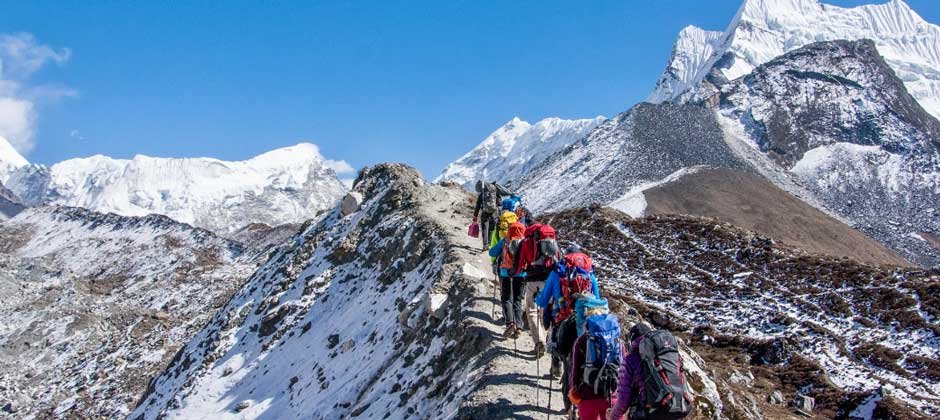Many people dream of reaching Mount Everest Base Camp, one of the hardest trails in the whole Himalayas, but very few really manage it. Entering the Everest base camp is not just a journey; it takes more than just financial and physical stamina.
When it comes to Mount Everest, some hikers who are unfamiliar with the region may misunderstand it and think that reaching the summit of the mountain (8848.86 meters) is the ultimate goal.
However, this is untrue; each year, hikers make the mistake of failing to investigate the ideal time of year to hike in the Himalayas. This is the case since they look for ways to offer the Everest Trek at a reduced price.
As everyone is aware, many hotels in the city and the Himalayas attempt to lower their rates during the off-season. In addition to hotels, both domestic and foreign airlines participate in this offer.
This occurs as a result of their desire to attract passengers who have a preference for inexpensive packages. This is universally applicable. Travelers follow the agency because they want to offset the cost of operating their business, and the result is a terrible trip.
Let’s now talk about the crucial information that hikers in Nepal’s Himalayas should never overlook. This is ‘The Weather’ without any objections. Although it seems like a simple term, the weather is really important in the Himalayas. The weather dictates how many days it will take you to complete the assignment and whether you can enter the Everest Base Camp.
Everest Base Camp Trek Weather in Spring Season (February, March, April, and May)
test seasons to hike to Everest Base Camp (10-Day) is thought to be the spring. This also applies to Nepal’s whole Himalayan region. This is the time of year when we can finally say goodbye to the icy winter and look forward to a long, hot summer and monsoon. The weather in the spring is just wonderful.
Foliage will be abundant along the trail; the higher we walk, the more we get. The Himalayan flowers are visible everywhere, with the rhododendron being one of the most captivating flowers in the Everest region.
There are extended periods of sunshine, a far visibility rate, and a pleasant temperature. There are stunning vistas of the Himalayas and clear skies.
The typical daytime temperature is 15°C, while the nighttime low is -10°C. Wind speeds are restricted to approximately 14 km/h. Together with seven hours of sunshine and fifteen millimeters of precipitation per month, this lowers the likelihood of rainfall.
Everest Base Camp Trek Weather in March
After winter, spring officially begins at this time of year. At the high altitude, the temperature stays mild and all of the lodges and tea shops that close in the winter begin to reopen.
March is better than January and February since the days are still short and the temperature is starting to rise. However, there’s still a chance for less snow to fall.
As a result, the daytime temperature is roughly 7°C, and the nighttime temperature is between -10° and -12°C. The Himalayas are now at a more comfortable and moderate temperature.
Everest Base Camp Trek Weather in April
One of the greatest months of the year to hike to Everest Base Camp is still April (12-Day). The daily high is roughly 10°C, while the overnight low is between 5°C and 7°C.
As we climb higher, we will be able to see the Himalayan flowers. At a lower height, we may see greenery around with recently blooming flowers.
Trekkers are still using the trails, and all of the hotels and tea places are open. The mountain, blanketed in snow, is incredibly attractive, and the skies stay blue with excellent visibility.
Everest Base Camp Trek Weather in May
May marks the end of the spring season and the beginning of the pre-monsoon season. The weather is clear for the first two to three weeks of this month, but as June approaches, the weather continues to change, and there may be some rainfall at lower elevations.
The monthly temperature in May varies from 15°C during the day to 0°C at night. The days are getting longer and more comfortable. Climbers prefer to reach the summit of the hill during this month because of the constant temperature increase.
This keeps the snow compacted and facilitates clear trails. Thus, it is possible to witness climbers making their way to the base camp in order to get ready.
If you wish to avoid any weather-related disruptions, it is better advised to reach Everest Base Camp before May 20th.
Everest Base Camp Trek Weather in Monsoon Season (June, July, and August)
In Nepal, the monsoon season is always warm and pleasant. It is when a variety of crops are cultivated, most notably rice, which is our major food. between Nepal, monsoon clouds are most active between June and August and might last until mid-September.
However, the monsoon season is still not ideal for tourists. The Everest Trek experienced a temperature spike during this period, going from 17°C during the day to 5°C at night.
The days are hot and muggy. The trail is muddy, mossy, and slippery at lower elevations due to the torrent of rain, and leeches are also prevalent during this time. Insects can occasionally find a decent location to shelter from the rain in lodges and tea houses.
The majority of trekkers do not like to hike during this time of year, so the temperature rises and melts the snow, but lodges, hotels, and airlines are still open and offering discounts.
Because of the busy monsoon clouds, mist, and fog, visibility is very low. Due to clouds, the amount of precipitation at the base camp also rises to 190 mm, and the wind speed increases to 16 km/h. The daily sunshine lasts for five hours. As a result, the solar panel is less active and there is inadequate internet and mobile phone access.
The Himalayas have only one power source: solar energy. Thus, monsoon season has an impact on this as well, which is beneficial for us because it allows us to charge our electronics and other gadgets.
Everest Base Camp Trek Weather in June
The monsoon season officially begins in June, but the regular deluge won’t begin until mid-June. In the Himalayas, the temperature reaches 17°C during the day and drops to -1°C at night, making this time of year similar to summer.
Because there are fewer hikers this season, the trek is serene and calm. The Himalayas are covered in clouds during the monsoon season, making for an unappealing vista; however, as we move higher, the view improves.
Everest Base Camp Trek Weather in July
There is ample precipitation in July. The trails are getting mossier, slick, and muddy as the weather warms.
The temperature rises to 17°C during the day and falls to 2°C at night. The trails are quiet and serene when we come across less experienced hikers. Lodges also stay silent, and you will be able to select from a variety of lodges.
The vistas are breathtaking despite the heat and humidity, and we advise bringing a raincoat during the monsoon season.
Everest Base Camp Trek Weather in August
Despite being part of the monsoon season, August has less rainfall than July. Though as we go uphill to gain a better perspective, the skies stay hazy at lower altitudes.
In the first two to three weeks of August, there will be rain at lower elevations. The temperature reaches 16°C during the day and drops to 2°C at night.
By the end of August, the weather begins to improve, and hiker traffic on the trails begins to increase.
Everest Base Camp Trek Weather in Autumn Season (September, October, and November)
Autumn is another popular season in Nepal for trekking and climbing, with millions of hikers choosing to fulfil their ambition of visiting the Khumbu region and other Himalayan regions of the country.
Since this is Nepal’s driest season, the Himalayan region’s temperature is comfortably warm but not oppressively cold. The average daily temperature is 15°C, although depending on height, it can occasionally reach 20°C during the day and -10°C at night.
Fall offers temperate temperatures ideal for hiking to Everest Base Camp, a nine-day destination with breathtaking Himalayan views. It is the season when there are a lot of hikers on the trail and little to no chance of rain.
In addition, the wind speed is 14 km/h. Sunshine and a high visibility rate make the hour seven days a week. You are also able to hike farther because of the pleasant weather and extended daylight.
Everest Base Camp Trek Weather in September
September is the first month of fall and the first month following the protracted monsoon season. This aids in the Everest Base Camp trail’s temperature drop.
We may receive rain until the first two weeks of the month, even though this is the first month following the monsoon, which is still extremely uncommon.
In comparison to other autumn months, the trail will still be less crowded with hikers during the day, which is still warmer at 15°C, and at night, which is just 2°C. The Himalayas can be seen magnificently with clear skies.
Everest Base Camp Trek (EBC) Weather in October
When it comes to the Everest Base Camp Trek during the autumn, October is thought to be the ideal month. The Himalayas are amazing to see at this time of year. The days continue to be sunny and bright, with clear mountain views and good visibility.
The high altitude experiences a slight drop in temperature towards the end of this month, with days remaining at 12°C and nights reaching -6°C.
In October, it is advisable to be well-prepared with a sleeping bag and all the equipment needed for winter trekking.
Additionally, this is the busiest trekking season of the year for all Himalayan paths, including the 16-day Everest Base Camp Trek. Thus, be sure to start looking for flights early, particularly domestic ones, and be ready for a rise in the cost of certain services as well as lodging.
Everest Base Camp Trek Weather in the month of November
The last month of the autumnal season is November. Even if the temperature drops to 6°C during the day and -12°C at night, the great height still offers an amazing view.
Since winter is almost here at this time of year, make sure you have all the necessary trekking equipment.
As the month draws to a close, the temperature drops even further, and fewer people go trekking.
Everest Base Camp Trek Weather in Winter Season (December, January, and February)
Although sunshine will be 7 hours per day we need to be well prepared for the extreme cool. So, it is recommended to carry winter trekking gear.
Apart from this if you seriously want to accomplish the Everest Base Camp trek during the winter season, better keep some extra reserve days. This is so because sometimes you might be stuck in bad weather and need to wait for an extra day to get the weather clear.
During this season of the year, trekking solo without a guide or porter is not a good idea, because the trail to the high Himalayas is mainly covered with snow, and lodges remain closed except for some. This might mislead you to other areas and might be in problem calculating your overnight camp.
We need to be well-prepared for the harsh cold even though there will be seven hours of sunshine each day. Thus, it is advised to pack for winter trekking.
Aside from this, you should set aside a few more days if you truly want to complete the Everest Base Camp hike in the winter. This is due to the possibility that you could occasionally get caught in inclement weather and have to wait an extra day for it to clear.
It is not a good idea to go hiking alone without a guide or porter during this time of year because the trail to the high Himalayas is mostly covered in snow and most lodges are closed. This can be problematic and take you in the wrong direction.
Everest Base Camp Trek Weather in December
At Everest Base Camp, December marks the start of winter with temperatures below freezing. During the day, it will be 4°C, and at night, it will be -14°C.
Snowfall is common during this time of year, and paths can occasionally deteriorate, mostly at high elevations.
Other than this, the days are gloomy and foggy, and the sky are still too dark to have great vistas as they are in other months of the year.
You will need to bring strong winter trekking gear and a thick sleeping bag that can withstand temperatures as low as -20°C because of the extremely low temperatures.Trekking to Everest Base Camp in January weather
The Himalayas are still experiencing intense cold in January, but the scenery and mountain views are stunning with plenty of snow.
The temperature is below freezing, with daytime highs of 4°C and nighttime lows of -17°C.
There will be snow on the trails because snowfall occurs frequently. It is occasionally necessary to reserve a day when the weather is suitable for hiking.
Owing to the harsh winter, there won’t be as many hikers on the trail, and the highest altitude lodgings will stay closed. Villagers avoid severe weather by moving towards lower altitudes. Have enough warm hiking clothing on hand.
Everest Base Camp Trek Weather in February
As the winter season comes to an end, February also marks the start of spring. The early half of February is still quite cold and isn’t thought to be the best time to go trekking.
The typical temperature variations are 6°C to -15°C, while the nighttime low is below freezing.
As the snow begins to melt, the weather is pleasant and the view from the base camp of Mount Everest is breathtaking. You can stroll along the trail with ease.
Trekkers will be visible on the trail, and by the end of February, lodges will be reopening to receive trekkers. With a high visibility rate and days that are sunny, bright, and clear toward the end of February, you can get breathtaking views of the Himalayas and the surrounding countryside.
The Crux of the Blog
The purpose of this blog is to genuinely update hikers on the weather along the Everest Base Camp trail. All year long, it is possible to trek to Everest Base Camp.
There will be rainfall even during the monsoon season at lower elevations, but the likelihood of precipitation decreases as we rise higher from Namche Bazaar. while the monsoon cloud is blocked by the Himalayas.
We can hike, and many people do, even though the Himalayas receive a lot of snowfall throughout the winter, all the way up to Everest Base Camp.
If you would rather experience the Nepalese Himalayas in all of their beauty. It is highly recommended that you hike to Everest Base Camp in the spring and fall. March, April, May, September, October, and November are among these two seasons. Additionally, you can choose from a variety of Everest Trek packages according on your interests and time schedule.
Trekking and expedition demand is highest during the spring and fall seasons. To be more exact, though, the weather in the Himalayas is wildly unpredictable. We also experience a lot of precipitation and rain during the unusual seasons.
You should never worry about the Everest Base Camp journey; the only requirements are to be in good physical and mental health and to be ready for any weather-related emergency.
One really encouraging thing to note is that all of the climate change that affects Nepal originates in the Indian Ocean and is caused by cyclones, tsunamis, etc. The cloud that forms from these events takes many days to reach the Himalayas of Nepal.
Trekkers can reach their intended destination more quickly by climbing and descending during this intermediate period. Trekkers have enough time to adjust to changing weather conditions.







